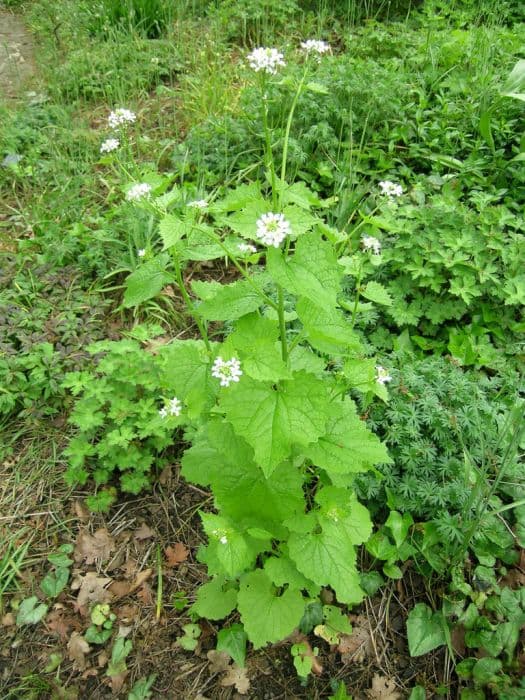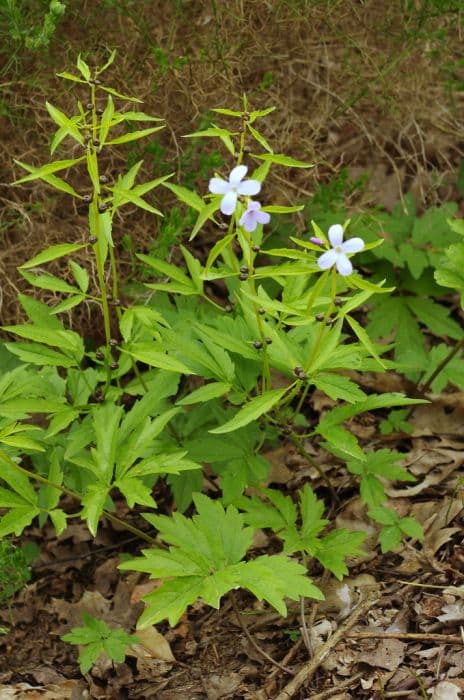Variegated Wallflower Erysimum linifolium 'Variegatum' (v)

ABOUT
Erysimum linifolium 'Variegatum', commonly known as the variegated wallflower, is a striking plant notable for its attractive foliage and flowers. The leaves are the key feature, displaying a beautiful variegation pattern. These leaves are slender, with edges that often appear creamy-white to pale yellow, contrasting against a central green color, giving the plant a bright and eye-catching appearance. Complementing its ornamental leaves, the variegated wallflower produces an abundance of small flowers. These blossoms are typically a rich shade of purple or violet, creating a stunning contrast with the variegated foliage. The flowers are formed in clusters at the tops of the stems and emit a pleasant fragrance that can attract butterflies and other pollinators to the garden. The plant has an overall bushy demeanor, with its stems often arching gracefully under the weight of the leaves and blooms. Together, the variegated leaves and attractive flowers create an appealing texture and color combination, making the variegated wallflower a favored choice for gardeners looking to add a splash of color and interest to their flower beds, borders, or containers.
About this plant
 Names
NamesFamily
Brassicaceae.
Synonyms
Variegated Wallflower, Variegated Perennial Wallflower, Variegated Lincolnshire Wallflower.
Common names
Cheiranthus linifolius, Cheirinia linifolia, Erysimum linifolium, Erysimum sulphureum, Erysimum cheiri var. linifolium.
 Toxicity
ToxicityTo humans
Variegated wallflower is not commonly known to be toxic to humans. However, it is always recommended that you do not eat ornamental plants or any plant parts if they are not explicitly intended for consumption, as they may cause adverse reactions or be potentially harmful due to other unknown substances.
To pets
Variegated wallflower is not commonly known to be toxic to pets. As with humans, it is generally recommended that pets avoid ingesting ornamental plants, as they may have varying sensitivity to plants that are not typically part of their diet. If a pet should ingest this plant and exhibit symptoms such as vomiting, diarrhea, or other unusual signs, contacting a veterinarian would be prudent.
 Characteristics
CharacteristicsLife cycle
Perennials
Foliage type
Evergreen
Color of leaves
Variegated
Flower color
Mixed
Height
1-2 feet (30-60 cm)
Spread
1-2 feet (30-60 cm)
Plant type
Shrub
Hardiness zones
7
Native area
Mediterranean
Benefits
 General Benefits
General Benefits- Attracts Pollinators: The flowers of Erysimum linifolium 'Variegatum', commonly known as Variegated Wallflower, are known to attract butterflies and bees, which are important for pollination in the garden.
- Low Maintenance: This plant is drought-tolerant once established, requiring minimal watering and care, which can conserve water and reduce maintenance efforts.
- Landscape Aesthetics: With its variegated foliage and vibrant blooms, it adds visual interest and aesthetic value to gardens and landscapes.
- Long Flowering Period: The Variegated Wallflower has a long blooming season, often from early spring to summer, providing a consistent display of color.
- Adaptability: This plant can adapt to a range of soil types, though it prefers well-drained conditions, making it versatile for different garden settings.
- Compact Growth: It grows into a neat, compact mound, making it suitable for borders, rock gardens, and small spaces.
 Medical Properties
Medical PropertiesThis plant is not used for medical purposes.
 Air-purifying Qualities
Air-purifying QualitiesThis plant is not specifically known for air purifying qualities.
 Other Uses
Other UsesWallflower 'Variegatum' can be used in dried floral arrangements; after flowering, its seed pods and colorful foliage retain an attractive shape and color, adding texture and interest.
Craft projects can incorporate Wallflower 'Variegatum'; pressed leaves and flowers can be used for making bookmarks or in decoupage.
Photographic subject; Its vibrant color and distinct variegated leaves can be the focus of artistic photography, especially macro photography.
Wallflower 'Variegatum' is suitable for container gardening, providing a splash of color on patios or balconies where ground planting isn't possible.
Educational purposes; gardening enthusiasts and botanical students can study the plant's growth habits, variegation patterns, and pollinator attractions as a learning model.
Culinary garnish; while not commonly eaten, the non-toxic flowers can be used to add a decorative touch to dishes in high-end culinary presentations.
Event decorations; fresh Wallflower 'Variegatum' can be incorporated into event decor, such as weddings or celebrations, for natural table settings.
Art and illustration; the distinctive look of Wallflower 'Variegatum' provides inspiration for artists and can be used as a reference for botanical illustration.
Fabric dye; historically, plants have been used to dye materials, and Wallflower 'Variegatum' could potentially be explored for its dyeing properties.
Natural crafting material; the stems and foliage can be used in the creation of wreaths and other rustic crafts.
Interesting Facts
 Feng Shui
Feng ShuiThe variegated wallflower is not used in Feng Shui practice.
 Zodiac Sign Compitability
Zodiac Sign CompitabilityThe variegated wallflower is not used in astrology practice.
 Plant Symbolism
Plant Symbolism- Resilience: Erysimum linifolium 'Variegatum,' commonly known as variegated wallflower, often symbolizes resilience as it is a hardy plant that can thrive in challenging environments and poor soils.
- Survival: The plant's ability to survive in tough conditions represents the human spirit's capacity to endure and overcome adversity.
- Adaptability: With its variegated leaves, the wallflower can symbolize adaptability and versatility, as it can adapt to its surroundings and still maintain beauty.
- Longevity: The wallflower has a long blooming period, which can represent a long and fruitful life or endurance over time.
- Constancy: Active throughout the seasons, the wallflower can represent faithfulness and unwavering affection.
 Water
WaterThe perennial Wallflower 'Bowles's Mauve' prefers even moisture but is tolerant of drought once established. Water the Wallflower thoroughly when the top inch of soil feels dry to the touch, which typically means weekly during active growth in spring and summer. Cut back on watering to every two to three weeks during the fall and only water monthly during winter when the plant is dormant. When watering, aim to provide about one gallon per square foot over the course of a month, adjusting as needed for rainfall and temperature conditions to maintain consistent soil moisture without overwatering.
 Light
LightWallflower 'Bowles's Mauve' thrives in full sun to partial shade. The best spot for this plant is one where it will receive at least six hours of direct sunlight daily, though some afternoon shade can be beneficial in hotter climates. Avoid deep shade as it will reduce flowering and can cause the plant to become leggy.
 Temperature
TemperatureWallflower 'Bowles's Mauve' prefers moderate temperatures and thrives in a range between 60 and 75 degrees Fahrenheit. It can tolerate temperatures down to about 20 degrees Fahrenheit but may suffer if the temperature drops lower. Warmer temperatures above 85 degrees Fahrenheit can stress the plant, so provide some shade during the hottest parts of the day in very warm climates.
 Pruning
PruningPrune Wallflower 'Bowles's Mauve' to remove spent flowers and encourage bushier growth, which can be done every few weeks during the blooming season. Cutting back the foliage by one-third after the first flush of blooms can stimulate a second bloom period. The best time for major pruning is late winter or early spring before new growth begins.
 Cleaning
CleaningAs needed
 Soil
SoilBowles' Mauve Wallflower thrives in well-drained soil with a neutral to slightly alkaline pH, generally between 7.0 and 7.5. The best soil mix for this plant is a combination of garden soil, compost, and gritty material like perlite or coarse sand to improve drainage.
 Repotting
RepottingBowles' Mauve Wallflower should be repotted every 2-3 years or when it outgrows its current container, which can be indicated by roots emerging from the drainage holes.
 Humidity & Misting
Humidity & MistingBowles' Mauve Wallflower prefers moderate humidity levels but is quite adaptable and can tolerate the lower humidity levels typically found in home environments.
 Suitable locations
Suitable locationsIndoor
Place in bright, indirect light and ensure good air circulation.
Outdoor
Plant in full sun with well-draining soil.
Hardiness zone
7-10 USDA
 Life cycle
Life cycleVariegated Wallflower (Erysimum linifolium 'Variegatum') begins its life cycle when seeds germinate, typically in spring, in well-draining soil and a sunny location. Seedlings emerge and develop into young plants with variegated, green and cream leaves, establishing a deep root system. The plant enters a vegetative stage, growing stems and foliage, and may form a bushy habit. As the plant matures, it produces clusters of fragrant flowers ranging from purple to mauve, typically in late spring to early summer, attracting pollinators such as bees and butterflies. After pollination, the plant sets seed, which can be collected or left to self-sow, completing the reproductive phase of its life cycle. In the absence of extremely cold winters, the Variegated Wallflower may exhibit perennial characteristics, surviving winter and re-sprouting the following spring, but it is often grown as a biennial or short-lived perennial.
 Propogation
PropogationPropogation time
Spring-early summer
Wallflower (Erysimum linifolium 'Variegatum') is usually propagated by cuttings, a popular method because it is relatively straightforward and results in a true copy of the parent plant. This is commonly done in late spring or early summer, when the plant is actively growing. To propagate, select a healthy, non-flowering shoot and cut a 3- to 4-inch (7.6 to 10.2 cm) section just below a leaf node. Strip off the lower leaves, dip the cut end into rooting hormone to encourage root growth, and plant the cutting into a pot filled with a mix of peat and perlite or sand for good drainage. Make sure to keep the cutting moist and in a warm environment, but out of direct sunlight. Roots typically develop within a few weeks, after which the new plant can be transplanted into the garden or a more permanent pot.








